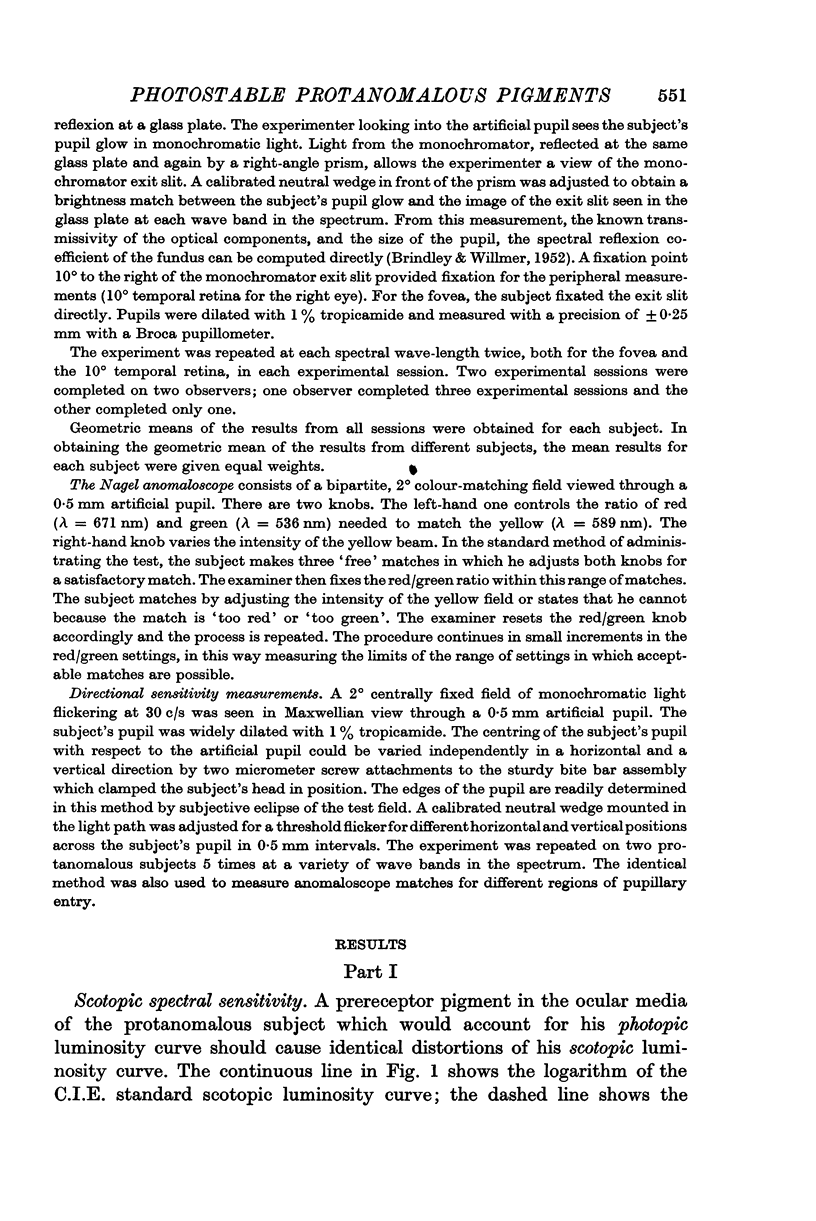Abstract
1. Scotopic luminosity and fundus spectral reflexion in the protanomalous fail to confirm predictions made from the hypothesis that protanomalous photopic luminosity loss is due to an inert red-absorbing filter in his ocular media.
2. If it were supposed that the luminosity losses were due to a reduced number of normal red cones, the anomaloscope mismatches could result from a prereceptor distortion such as a reduced concentration of macular pigment or a tilt of the foveal cones. Experiments exclude these two possibilities.
3. An anomaloscope is described which makes it possible to measure colour-matching properties of the protanomalous eye by transcleral illumination. Such measurements exclude, as a class, hypotheses which attribute protanomalous colour-matching distortions to an inert filter localized anywhere between the cone outer segment and the cornea.
4. It is concluded that the absorption spectrum of at least one of the three cone visual pigments of the protanomalous eye must differ from that of the pigments of the normal fovea.
Full text
PDF











Selected References
These references are in PubMed. This may not be the complete list of references from this article.
- Alpern M., Thompson S., Lee M. S. Spectral transmittance of visible light by the living human eye. J Opt Soc Am. 1965 Jun;55(6):723–727. doi: 10.1364/josa.55.000723. [DOI] [PubMed] [Google Scholar]
- BRINDLEY G. S., RUSHTON W. A. The Colour of monochromatic light when passed into the human retina from behind. J Physiol. 1959 Jun 23;147(1):204–208. doi: 10.1113/jphysiol.1959.sp006235. [DOI] [PMC free article] [PubMed] [Google Scholar]
- BRINDLEY G. S. The effects on colour vision of adaptation to very bright lights. J Physiol. 1953 Nov 28;122(2):332–350. doi: 10.1113/jphysiol.1953.sp005003. [DOI] [PMC free article] [PubMed] [Google Scholar]
- BRINDLEY G. S., WILLMER E. N. The reflexion of light from the macular and peripheral fundus oculi in man. J Physiol. 1952 Mar;116(3):350–356. doi: 10.1113/jphysiol.1952.sp004709. [DOI] [PMC free article] [PubMed] [Google Scholar]
- ENOCH J. M., STILES W. S. The colour change of monochromatic light with retinal angle of incidence. Optom Wkly. 1961 Oct;8(52):329–358. doi: 10.1080/713826396. [DOI] [PubMed] [Google Scholar]
- FRY G. A. PRENTICE LECTURE. MECHANISMS SUBSERVING COLOR VISION. Am J Optom Arch Am Acad Optom. 1965 May;42:271–287. doi: 10.1097/00006324-196505000-00003. [DOI] [PubMed] [Google Scholar]
- MARKS W. B., DOBELLE W. H., MACNICHOL E. F., Jr VISUAL PIGMENTS OF SINGLE PRIMATE CONES. Science. 1964 Mar 13;143(3611):1181–1183. doi: 10.1126/science.143.3611.1181. [DOI] [PubMed] [Google Scholar]
- RUSHTON W. A. A CONE PIGMENT IN THE PROTANOPE. J Physiol. 1963 Sep;168:345–359. doi: 10.1113/jphysiol.1963.sp007196. [DOI] [PMC free article] [PubMed] [Google Scholar]
- RUSHTON W. A. STRAY LIGHT AND THE MEASUREMENT OF MIXED PIGMENTS IN THE RETINA. J Physiol. 1965 Jan;176:46–55. doi: 10.1113/jphysiol.1965.sp007534. [DOI] [PMC free article] [PubMed] [Google Scholar]
- Rushton W. A., Baker H. D. Red--grees sensitivity in normal vision. Vision Res. 1964 May;4(1):75–85. doi: 10.1016/0042-6989(64)90034-3. [DOI] [PubMed] [Google Scholar]
- WALLS G. L., MATHEWS R. W. New means of studying color blindness and normal foveal color vision, with some results and their genetical implications. Publ Psychol. 1952 Apr 29;7(1):1–172. [PubMed] [Google Scholar]
- Wald G., Brown P. K. Human color vision and color blindness. Cold Spring Harb Symp Quant Biol. 1965;30:345–361. doi: 10.1101/sqb.1965.030.01.035. [DOI] [PubMed] [Google Scholar]


